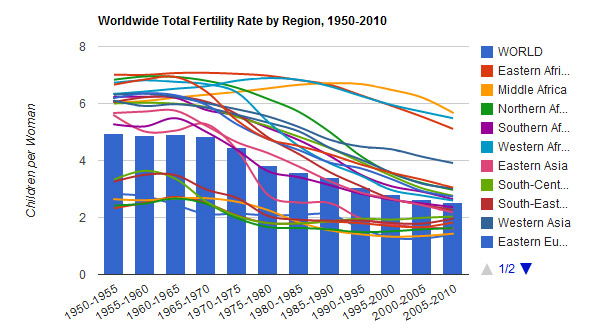-
One in Three People Will Live in Sub-Saharan Africa in 2100, Says UN
June 8, 2011 By Schuyler NullBetween now and 2100, three out of every four people added to world population will live in sub-Saharan Africa. That’s what the medium variant of the UN’s world population projections estimates.* As we noted in our previous post on the latest UN numbers, Nigeria leads sub-Saharan growth, but other countries will also grow by major multiples: Tanzania and Somalia will be 7 times larger; Malawi more than 8 times; and Niger, to grow to more than 10 times its current population.
Between now and 2100, three out of every four people added to world population will live in sub-Saharan AfricaSub-Saharan Africa’s growth, if it follows these projections, will likely have important geopolitical repercussions. Today, the region is home to more than 877 million people, or roughly 12 in every 100 people on Earth. In 2100, the medium-variant projection for sub-Saharan population is 3.36 billion people, or one in every three people on the planet. Such an increase in human capital could be a major asset, but whether or not economies can grow quickly enough to accommodate it – as well as provide the number of new schools, hospitals, infrastructure projects, and other services that will be needed in general – will be a crucial challenge.
For example, a population and development report by the Ethiopian government issued last fall projects that the country would need to create 5.4 million new jobs, provide 21.2 million metric tons of additional cereals, and quadruple their number of doctors by 2035 to meet basic requirements under a plausible high fertility scenario.
“The question for Africa is: Are we going to be ready?” said Eliya Zulu of the African Institute for Development Policy in Kenya, speaking to ECSP earlier this year about the impending demographic hurdles facing African leaders. “We need to prepare,” he said, and “for that to happen it’s not just about saying ‘let’s have fewer children.’ I think we also need to do this from a social developmental perspective where we also look at ways in which we can improve the quality of the population, empower women, invest in education, and so on.”
Demographic Momentum and Uncertainty
It’s important to note that the UN’s numbers are based on projections that can and do change. The range of uncertainty for the sub-Saharan African region, in particular, is quite large. The medium-variant projection for the region’s total population in 2100 is 3.36 billion people, but the high variant projection is 4.85 billion and the low variant is 2.25 billion. The vast differences between projections (the lower variant is less than half of the high) are due to the predicted trajectory of total fertility rate (TFR, or average number of children per woman). Historically, TFR has declined – sometimes very quickly – as countries develop, but it has remained stubbornly high throughout many parts of sub-Saharan Africa.
Compared to the rest of the world, the region’s TFR has declined much more slowly over the last few decades than anywhere else (see figure above) – the Middle African sub-region’s TFR even rose during the 1980s and 90s. As a result, the date when countries in sub-Saharan Africa will reach a TFR of 2.1 (considered “replacement level” – when population stabilizes) has been repeatedly pushed back, and some experts expect this “demographic stalling” to continue. This uncertainty leads to the high variability in the UN Population Division’s population projections.
Turning the Ship
Certainly one avenue for steering the region’s growth towards the lower variant is an increased focus on family planning (listen to Eliya Zulu’s take on this as well). Only 18 percent of married women in sub-Saharan Africa currently use modern contraceptives, according to the Population Reference Bureau, and at least 35 million women want to delay or stop childbearing but do not have access to contraceptives. Doing so would not only reduce overall population growth to more manageable levels faster, but also address child and maternal health indicators and help increase resilience in areas where climate change is expected to have negative impacts (a large portion of the region, unfortunately).
The UN projections illustrate the sheer mathematical challenge that sub-Saharan African leaders faceBecause of the momentum of demographic change, much of the projected near-term growth in sub-Saharan Africa is fairly unavoidable. In the long term, however, reducing total fertility rate can bend the region’s trajectory towards the low-variant projection, which would mean the difference between a median age as high as 41 years old in 2100 (Sweden today) or as low as 30 (Tunisia in a year or two).
In addition to allaying economic and development pressures, a more mature age structure can reduce the chances of youth-related civil conflict and political instability, such as what we’ve seen in the Middle East during the Arab Spring.
Despite the inherent fuzziness of estimates that extend so far into the future, the UN projections illustrate the sheer mathematical challenge that sub-Saharan African leaders face in meeting developmental goals and highlight the importance of demographics to planning for the future.
*It should be noted that Asia’s bell curve of mid-century growth and then decline by 2100 is masked using a simple start/end-date calculation. In 2053, when Asia’s population is projected to peak, sub-Saharan Africa would represent only 36 percent of the world’s total growth increment. The difference is that sub-Saharan Africa is projected to keep growing through the end of the century, while Asia is projected to peak and then decline.
Sources: Ministry of Finance and Economic Development (Ethiopia), Population Reference Bureau, UN Population Division.
Chart Credit: Data from the UN Population Division, arranged by Schuyler Null.
Topics: Africa, demography, development, economics, family planning, featured, Malawi, Niger, Nigeria, population, Somalia, Tanzania, UN
 A Publication of the Stimson Center.
A Publication of the Stimson Center.





